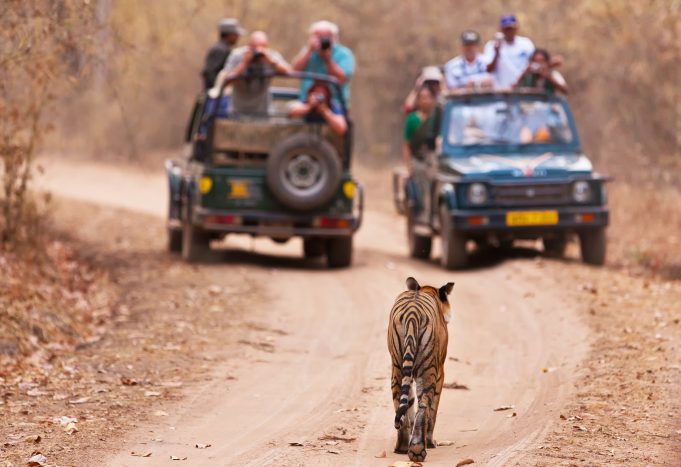We guide you on ethical conduct when visiting a wildlife sanctuary or forest…
Hundreds of wildlife sanctuaries across the versatile Indian sub-continent safeguard native habitats and ecosystems within their confines. They should be revered as sacred places for the sake of our present wellbeing and future existence.
There exists gradation among areas protected for conservation in India, ranging from zoological parks to national parks, wildlife sanctuaries or reserve forests. The general and most obvious distinction is the extent to which the human public is permitted to enter, use/interact with the land and its inhabitants.
All visitors need to be guided by a basic understanding of ethical human conduct when visiting a wildlife sanctuary.
Disclaimer: The very presence of humans is an intrusion to the life of any given location. So, tread with caution regardless, and make it your objective to minimize your impact as far as possible.
Some tips:
- The right mindset: It is a common misconception that us not being able to spot/sight any animals implies an absence of the latter – quite the contrary. In fact, the sensitivities of non-human life/wildlife (in general) are far superior to ours, in different ways. It is more likely that the living creatures present have already taken note of your presence minutes before you arrive at any given spot, and will intentionally ‘escape’ encounters by moving away.
- What you wear: Always go with dull-colored clothing; absolutely stay away from bright, dazzling or fluorescent colors – a major no-no. In some regions (such as parts of the Western Ghats), it would serve you well to also stay away from wearing camouflage clothing because when forest guards see camouflage, a red flag goes off in their head equating camo to ‘Naxals’ who commonly wear them.
- No scents: Do not intentionally spray or slather on any artificial scents such as perfume, lotion, essential oils or incense. Animals are highly sensitive and artificial fragrances are irritants that disturb and disorient. Besides, you are likely to see less wildlife as the scent is a dead giveaway of human presence to surrounding animals who are unlikely to stick around for a courteous ‘how do you do?’!
- Do not assume: Don’t make assumptions on what is natural and what isn’t. For example, did you know throwing an orange peel (something we consider ‘natural’ because it is organic material) in a scrub jungle (commonly found in India), would violate the innate ecological integrity. Why? Because oranges may be made of ‘natural’ material but they certainly aren’t native to where you are. By throwing the peel and seeds, you are inadvertently propagating the fruit which, over time or in large quantity, will affect the ecological balance.
- Fire: Do not mess around with fire in any way. It is dangerous and unpredictable and best to refrain from jokes, pranks or unnecessary starting of fires. Just like dry leaves, grasses are highly flammable too.
- Sound: Maintain total silence. Do not play loud music or shout out to each other. If you’re wondering about those portable speakers, leave them behind. The quieter you are, the greater are your chances of encountering wildlife.
- Garbage: Do not, at any cost, throw garbage in the sanctuary – not even bio waste/organic material. Carry a designated garbage bag and ensure everybody uses it. An effective principle to be guided by: ‘the only thing to leave behind are your footsteps’.
- Do not disturb: Do not tamper with (elements of) the environment in any way. This includes touching, prodding, poking, carving. Even a simple thing such as lifting a rock can displace or hurt the umpteen worms, snakes, termites, geckos and other such animals of the microhabitat who take shelter under it. In a nutshell, keep your hands to yourself.
- Strictly no takeaways: It may seem harmless to carry back one tiny shell as a memory, but it is not. Millions of shells break down over thousands of years to form sand. This and hundreds of other natural processes are what the forest thrives on; removing elements messes with this order. Do not carry back rocks, pebbles, driftwood, plants, seeds or anything at all. Remember, with nature, every part has a purpose in the whole, essential to the natural cycles such as erosion and decomposition.
- Mind your own business: Do not try to interact with the animals you encounter. Even if you are with a trained naturalist or any other kind of expert, refrain from excessive handling and intrusion. Never feed or offer animals food.
- Stick with the plan: If you have instructions to leave the sanctuary by a certain time, get out when you’re supposed to. If you don’t, stick to the plan you have prepared and practice risk assessment for your own good.
- Ethical photography: Refrain from the use of flash. Photographers are known to ‘set up’ shots for themselves using the most inhumane and unethical methods to capture that perfect ‘natural’ shot. Baiting animals or cornering them to get a shot is selfish, distressing and causes harm to the innocent animals involved.
- Nests and nesting animals: Leave nests and nesting animals alone. In fact, if you chance upon a feeding mother, clear the scene and make sure you only observe from afar. Do not handle birds’ nests, eggs, dens of animals or any other such elements related to breeding.















































